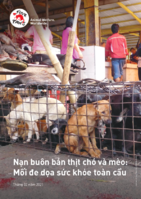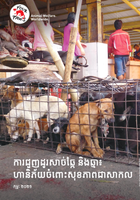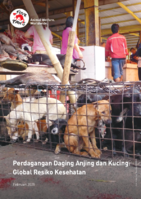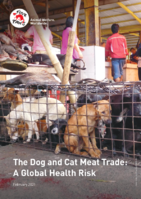
A Global Health Risk
Live animal markets and trades provide optimal conditions for deadly pathogen emergence and the transmission of viruses to humans
The COVID-19 pandemic has had a devastating toll globally; not only in terms of its impact on global health but also economically with widespread job losses and the livelihoods of millions threatened. As the world struggles with the effects of the disease, it is important to consider and understand how it came about in the first place so that measures can be taken to reduce the chances of other pandemics happening in the future.
COVID-19 is believed to have originated in a live animal market in Wuhan, China, as the result of zoonotic transmission. It is widely accepted that the conditions in such live animal markets provide the perfect environment for the emergence of novel zoonotic pathogens, and many pathologists and virologists have warned authorities of the public health dangers that these conditions represent. While the COVID-19 pandemic is certainly not the first time that infectious diseases have been linked to human activities that bring animals of various species and sources into close proximity with each other and humans, the scale and devastation of this pandemic are unprecedented. This raises the question of why actions were not taken sooner to address the risks of this type of animal trade when the zoonotic risk factors were known to be high.
While most recent international public and political attention is focused on the trade and sale of wildlife species, the risks posed by the mostly illegal and unregulated dog and cat meat trade (DCMT) continue to be largely ignored. This is despite mounting evidence that it is not only increasingly controversial, but also poses a very real threat to human and animal health and welfare. The trade involves up to 30 million dogs and cats each year throughout Asia, the majority of which are stray animals taken from the streets, or stolen pets. These animals are often taken to markets to be sold for slaughter alongside wildlife species. At the markets and generally, the trade operates in breach of existing laws and regulations pertaining to infectious disease control, sanitation, cross border transportation, theft, and animal welfare.
The true scale of the risks the dog and cat meat trade poses to both public and animal health is difficult to quantify given the nature of the operations of the trade, its reliance on a supply of animals of unknown health status and origins, as well as illegal operations. However, there is mounting evidence that the trade poses significant risks to global health – on top of well-known zoonotic risks of the trade that have directly been seen, such as rabies and anthrax. It is clear that the dogs and cats in the trade serve as a significant reservoir for the emergence and spread of zoonotic pathogens, including viruses due to their treatment. Despite warnings from leading experts in human and animal health, inter-governmental organisations and epidemiologists, the overwhelming majority of animal trade and markets throughout Asia continue to operate largely unchallenged, providing almost identical environments to those from which COVID-19 is thought to have emerged, and potentially exposing millions of people every day to a variety of zoonotic diseases.
Animal trade that affects national and international health, welfare and stability can no longer be ignored or defended as personal choice or culture. Now is a critical time for countries around the world to introduce and implement policies banning the breeding, capture, sale, and slaughter of dogs and cats, to reduce the risk of future pandemics and to safeguard human and animal health and welfare.
Read the whole report here:

Please find here the Vietnames version of the report
Nạn buôn bán thịt chó và mèo: Mối đe dọa sức khỏe toàn cầu

Please find here the Khmer version of the report
ការជួញដូរសាច់ឆ្កែ និងឆ្មា៖ ហានិភ័យចំព ោះសុខភាពជាសាកល

Please find here the Bahasa Indonesia version of the report
Perdagangan Daging Anjing dan Kucing: Global Resiko Kesehatan

Please find here the German version of the report
Der Handel mit Hunde- und Katzenfleisch: Ein globales Gesundheitsrisiko
The dog and cat meat trade – an ignored public health risk
Millions of dogs and cats are being taken, traded and slaughtered for consumption every year across much of Asia, and in light of the serious public health threat that these trades pose, it is the responsibility of regional and national governments around the world to do everything in their power to eliminate sources of disease outbreaks. Any policies and practices that sustain the dog and cat meat trade not only prohibit any attempts to eliminate rabies – given that the dog and cat meat trade and rabies elimination programmes are incompatible – but also carry a huge and unpredictable public health risk that could lead to future outbreaks and pandemics of zoonotic diseases among human populations.
Based on scientific evidence and expert recommendations, we thereby urge the governments throughout the region to take urgent preventative measures by:
- Issuing a comprehensive Law or Directive prohibiting all aspects of the dog and cat meat trade, including trafficking, sale, slaughter and consumption.
- Ensuring the closure of all markets and facilities selling and/or slaughtering live dogs and cats.
- Issuing public statements regarding the public health dangers of slaughter and consumption of dogs and cats.
- Taking strong measures to ensure the enforcement of existing laws, regulations and directives to end the dog and cat meat trade.
It is essential that governments around the world act to address the source of deadly zoonotic pathogens – believed in the case of COVID-19 to be a live animal market where human and various species of animals are brought into close proximity – to ensure they are not the point of origin of the next pandemic.


